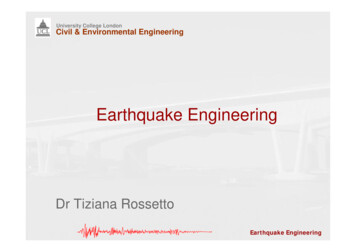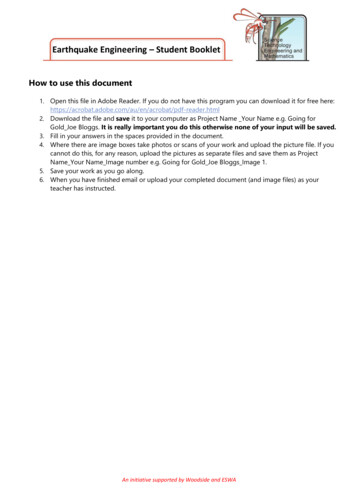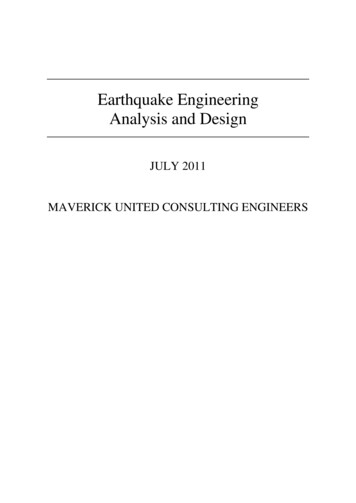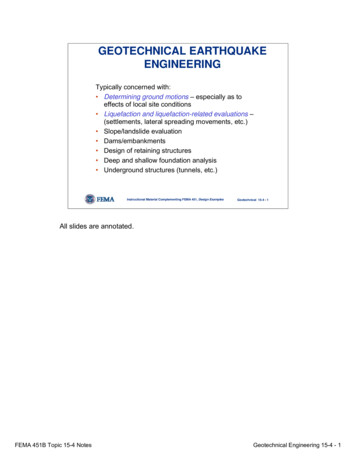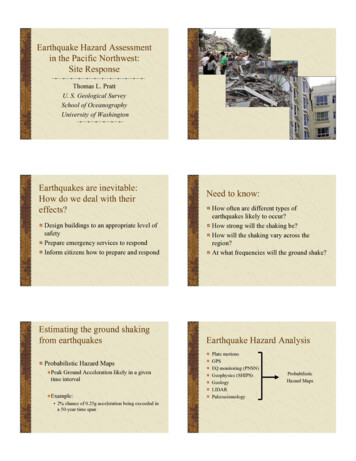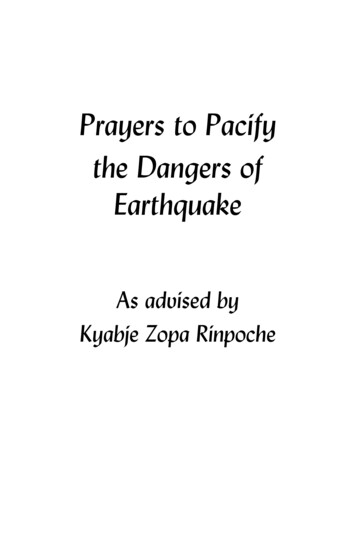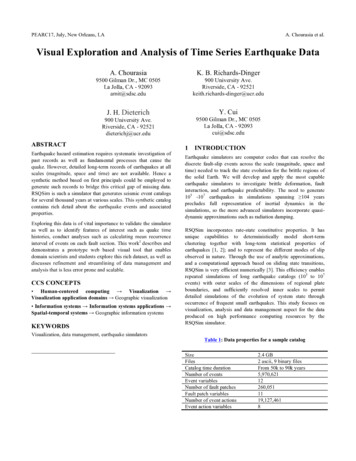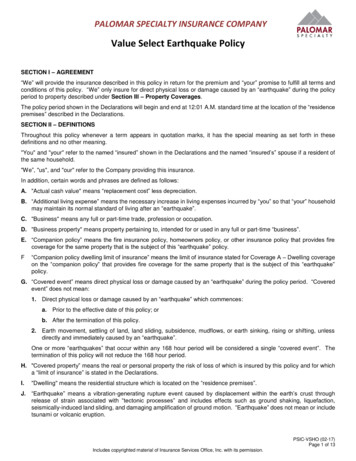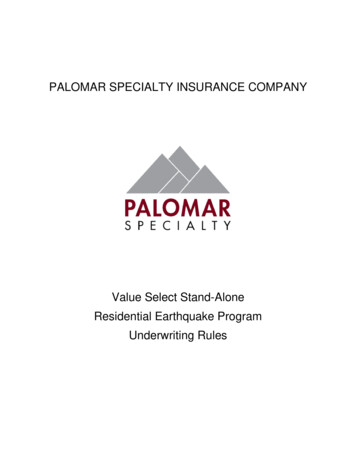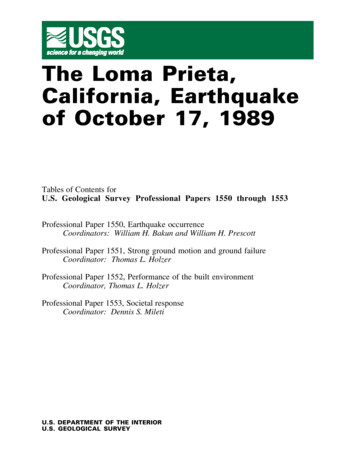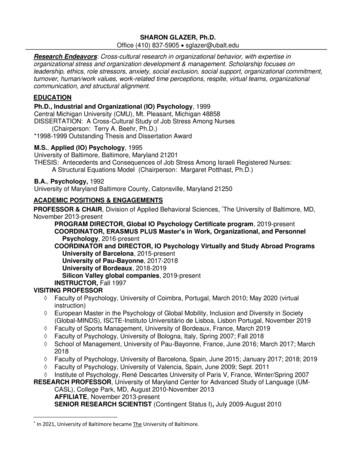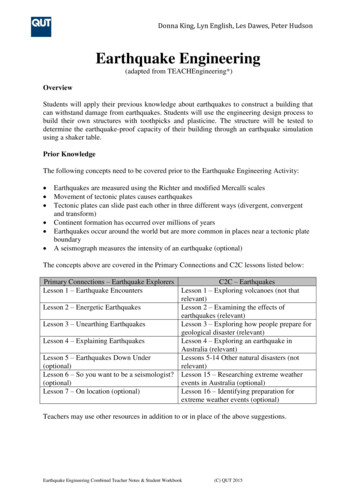
Transcription
Donna King, Lyn English, Les Dawes, Peter HudsonEarthquake Engineering(adapted from TEACHEngineering*)OverviewStudents will apply their previous knowledge about earthquakes to construct a building thatcan withstand damage from earthquakes. Students will use the engineering design process tobuild their own structures with toothpicks and plasticine. The structure will be tested todetermine the earthquake-proof capacity of their building through an earthquake simulationusing a shaker table.Prior KnowledgeThe following concepts need to be covered prior to the Earthquake Engineering Activity: Earthquakes are measured using the Richter and modified Mercalli scalesMovement of tectonic plates causes earthquakesTectonic plates can slide past each other in three different ways (divergent, convergentand transform)Continent formation has occurred over millions of yearsEarthquakes occur around the world but are more common in places near a tectonic plateboundaryA seismograph measures the intensity of an earthquake (optional)The concepts above are covered in the Primary Connections and C2C lessons listed below:Primary Connections – Earthquake ExplorersLesson 1 – Earthquake EncountersLesson 2 – Energetic EarthquakesLesson 3 – Unearthing EarthquakesLesson 4 – Explaining EarthquakesLesson 5 – Earthquakes Down Under(optional)Lesson 6 – So you want to be a seismologist?(optional)Lesson 7 – On location (optional)C2C – EarthquakesLesson 1 – Exploring volcanoes (not thatrelevant)Lesson 2 – Examining the effects ofearthquakes (relevant)Lesson 3 – Exploring how people prepare forgeological disaster (relevant)Lesson 4 – Exploring an earthquake inAustralia (relevant)Lessons 5-14 Other natural disasters (notrelevant)Lesson 15 – Researching extreme weatherevents in Australia (optional)Lesson 16 – Identifying preparation forextreme weather events (optional)Teachers may use other resources in addition to or in place of the above suggestions.Earthquake Engineering Combined Teacher Notes & Student Workbook(C) QUT 2015
Donna King, Lyn English, Les Dawes, Peter HudsonObjectivesStudents will: Engage in the Engineering Design Process Learn about the factors that make buildings earthquake-proof, including crossbracing, large ‘footprints’, base isolation and tapered geometry Model an earthquake-proof structure using simple materials Understand the importance of engineering for designing earthquake-proof buildings Understand the properties of shapes, and how combining shapes yields new propertiesand relationships Explore how combining shapes can increase structural strengthClass Time: 3 hours (approx.)Materials Combined Teaching Notes/Student WorkbookStudent WorkbookQUT supplied teacher DVD containing:o a. Video – Earthquakes 101 – National video/101-videos/earthquake-101)o b. Cross-bracing diagramo c. Base isolation photographo d. Engineering Design Modelo e. Engineering Adventures - Shake Things Up – Museum of Science (includesinstructions for constructing a shaker table on pp. 10 – 12)o f. Link to TEACHEngineering online resource – Hands-on Activity - Earthquake inthe Classroom(https://www.teachengineering.org/view activity.php?url collection/cub /activities/cub natdis/cub natdis lesson03 activity1.xml)Pack containing: 8 regular toothpicks, 2 x 8cm skewer pieces (for diagonal cross-bracing)and a little plasticine (1 per student)Pack containing: 12 regular toothpicks, a little plasticine, 2 metal plates and 6 cylindricalwooden sticks (one per class)Toothpicks (about 50 per group)Skewers (about 10 per group)2 – 3 shaker tables per class (QUT to supply using instructions included on teacher DVD)Plasticine (1 stick per group)Pencil, rubber, ruler, scissors – student supplied*https://www.teachengineering.org/view activity.php?url collection/cub /activities/cub natdis/cub natdis lesson03 activity1.xmlEarthquake Engineering Combined Teacher Notes & Student Workbook(C) QUT 20152
Donna King, Lyn English, Les Dawes, Peter HudsonCurriculum LinksTechnologyDesign and Technologies Knowledgeand UnderstandingScienceEarth and Space Science MathsMeasurement and GeometrySudden geological changes or extreme weather Using units of measurement Investigate how people in design andconditions can affect Earth’s surfacetechnology occupations address(ACSSU096) Convert between common metric units ofcompeting considerations, includinglength, mass and capacity (ACMMG136)sustainability in the design of products, Science as a Human Endeavourservices and environments for current Connect volume and capacity and their Science involves testing predictions byand future use (ACTDEK019)units of measurement (ACMMG138)gathering data and using evidence to developexplanations of events and phenomenaShapeDesign and Technologies Processes and(ACSHE098)Production Skills (ACARA) Construct simple prisms and pyramids(ACMMG140) Scientific understandings, discoveries and Generate, develop, communicate andinventions are used to solve problems thatdocument design ideas and processesGeometric Reasoningdirectly affect peoples’ lives (ACSHE100)for audiences using appropriatetechnical terms and graphical Investigate, with and without digital Scientific knowledge is used to informrepresentation techniquestechnologies, angles on a straight line,personal and community decisions(ACTDEP025)angles at a point and vertically opposite(ACSHE220)angles. Use results to find unknown angles Negotiate criteria for success that(ACMMG141)include consideration of sustainabilityto evaluate design ideas, processes andsolutions (ACTDEP027)Earthquake Engineering Combined Teacher Notes & Student Workbook(C) QUT 2015
Donna King, Lyn English, Les Dawes, Peter HudsonPart 1: Introduction View the video Earthquakes 101 – National Geographic in light of the work coveredpreviously and to orient the students to the engineering activity on building o/101-videos/earthquake-101 Discuss with students how earthquakes can cause walls to crack, foundations to move andeven entire buildings to crumple, therefore engineers incorporate into their structuraldesign, techniques that can withstand damage from earthquake forces.Ask: What are some ideas that engineers may use to make the buildings stronger towithstand the earthquake? Cross-Bracing: Explain that engineers (in this case mainly structural engineers) areinvolved in using special design techniques and structures that contribute to a morestable structure that can withstand the damage. Examples of these techniques are crossbracing, tapered geometry and base isolation.Activity: Ask the students to take four toothpicks and some plasticine and make asquare. Ask students to push the square sideways to see what happens. Then askstudents to take two skewers cut to size (8cm) and cross them in the middle of thesquare using plasticine to secure. Ask students to push the square sideways againand explain what happens. What was the difference between the two structures?Explain that cross-bracing is a construction technique in which braces are crossed to forman X shape to support a frame.The above diagram is included on the teacher DVD if teachers wish to display it to theclass.Earthquake Engineering Combined Teacher Notes & Student Workbook(C) QUT 20154
Donna King, Lyn English, Les Dawes, Peter Hudson Tapered Geometry: Explain that engineers can use geometrical shapes that can sustainthe movement received from an earthquake.Activity: Ask children to build a square-based pyramid with their toothpicks.This is known as “tapered geometry” where the top of the shape tapers to a point. Suchstructures decrease in size as the structure gets taller. In other words, shorter buildings arestronger if they have a point at the top. Base Isolation: Engineers use the word “footprint” to represent the base of the building,which can be large or small. Earthquake-proof buildings are intended to bend and swaywith the motion of earthquakes, or are isolated from the movement by sliders.The building on the right has used “base isolation” while the building on the left has not.The above photo is included on the teacher DVD if teachers wish to display it to the class.Teacher demonstration: Use two metal plates and six cylindrical wooden sticks tomodel base isolation. Firstly, place a cube made from toothpicks and plasticine onone piece of metal on the table and move vigorously from side to side. What happensto the cube? (It will most likely topple over.) Secondly, put the cylindrical sticksbetween the two pieces of metal and the cube on top. Move the bottom piece of metalfrom side to side and ask students to observe what happens to the cube. What is thedifference between the first example and the second? (The cylindrical sticks act toisolate the base and allow the top layer to move less.)Earthquake Engineering Combined Teacher Notes & Student Workbook(C) QUT 2015
Donna King, Lyn English, Les Dawes, Peter Hudson Summarise with students: Engineers use many special design features to enable buildingsto be earthquake resistant. We have seen three examples – cross-bracing, taperedgeometry and base isolation.Part 2: Engineering Design ProcessRemind students of the Engineering Design Process that they have done in previousengineering units. Ask students to explain the process to check for understanding. A copy ofthe process can be found on the teacher DVD. This can be referred to during the discussionand left displayed on the whiteboard for students to access during the challenge.NOTE: Engineering model has changed – if they wish, students can now experiment with thematerials before designing.Engineering Design IGNTESTSOLUTIONModel adapted from pbs.org modelHand out Student Workbooks and ask students to complete their name, group members,group number, class and school on the front.Earthquake Engineering Combined Teacher Notes & Student Workbook(C) QUT 20156
Donna King, Lyn English, Les Dawes, Peter HudsonStudent workbookYear 6Name:Other group members:Group Number:Class:School:Earthquake Engineering Combined Teacher Notes & Student Workbook(C) QUT 2015
Donna King, Lyn English, Les Dawes, Peter HudsonPart 3: Designing an Earthquake Resistant Structure IntroductionTell students that today they are acting as if they are engineers. They will make models ofbuildings and conduct an experiment to test how well their structures stand up to the stress ofan earthquake. Explain to them that this is similar to what some civil (structural) engineers doas their jobs. PROBLEM (Workbook page 3)Your team has been asked by AusAid, an organization that manages projects for countries inneed, to design a building that can withstand an earthquake in the Philippines. Acting likestructural engineers, you will design, build and test a structure that can withstand anearthquake simulated by a table constructed by a QUT engineer. Since the Earth has limitedresources, so too do engineers. For this reason you will need to work within a budget.Remember to follow the Engineering Design Model. Materials and Equipment (Workbook page 3) toothpicks ( 0.30 each)skewers ( 1.00 each)plasticine ( 1.00 per stick)scissorsshaker table Challenge (Workbook page 3)Using the materials listed, you will design a building with the following constraints:a. The building must be at least 12cm (two storeys) high(Explain to students that one storey one toothpick.)b. The building must contain at least one trianglec. The building must contain at least one squared. There must be evidence of cross-bracing to reinforce the structuree. You may use whole toothpicks or skewers cut to sizef. You have a budget of 40.00 (maximum) to spendThe group whose final design does not fall over and remains in the exact shape it was beforetesting is the winner of the Engineering Challenge. If more than one group achieves this, thehighest and/or least expensive structure will win.Earthquake Engineering Combined Teacher Notes & Student Workbook(C) QUT 20158
Donna King, Lyn English, Les Dawes, Peter HudsonDESIGNING AN EARTHQUAKE RESISTANT BUILDING1. PROBLEMYour team has been asked by AusAid, an organization that manages projects for countries inneed, to design a building that can withstand an earthquake in the Philippines. Actinglike structural engineers, you will design, build and test a structure that can withstand anearthquake simulated by a shaker table constructed by a QUT engineer. Since the Earth haslimited resources, so too do engineers. For this reason you will need to work within abudget.Remember to follow the Engineering Design Model.2. Materials and Equipment toothpicks ( 0.30 each)skewers ( 1.00 each)plasticine ( 1.00 per stick)scissorsshaker table3. ChallengeUsing the materials listed, you will design a building with the following constraints:g.h.i.j.k.l.The building must be at least 12cm (two storeys) highThe building must contain at least one triangleThe building must contain at least one squareThere must be evidence of cross-bracing to reinforce the structureYou may use whole toothpicks or skewers cut to sizeYou have a budget of 40.00 (maximum) to spendThe group whose final design does not fall over and remains in the exact shape it wasbefore testing is the winner of the Engineering Challenge. If more than one groupachieves this, the highest and/or least expensive structure will win.Earthquake Engineering Combined Teacher Notes & Student Workbook(C) QUT 2015
Donna King, Lyn English, Les Dawes, Peter Hudson BRAINSTORM (Workbook page 5)Explain that cubes and triangles are like building blocks that may be stacked to make towers.The towers can have small or large ‘footprints’ (or bases).Have students record answers to the following questions in their Student Workbook. What shapes will you use for your building?How tall will your building be?Where will you use either cros
Earthquake Engineering Combined Teacher Notes & Student Workbook (C) QUT 2015 6 Summarise with students: Engineers use many special design features to enable buildings to be earthquake resistant. We have seen three examples – cross-bracing, tapered geometry and base isolation. Part 2: Engineering Design Process . Remind students of the Engineering Design Process
